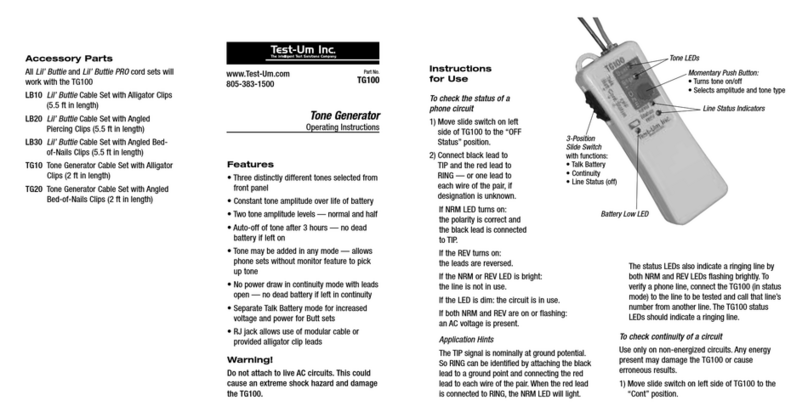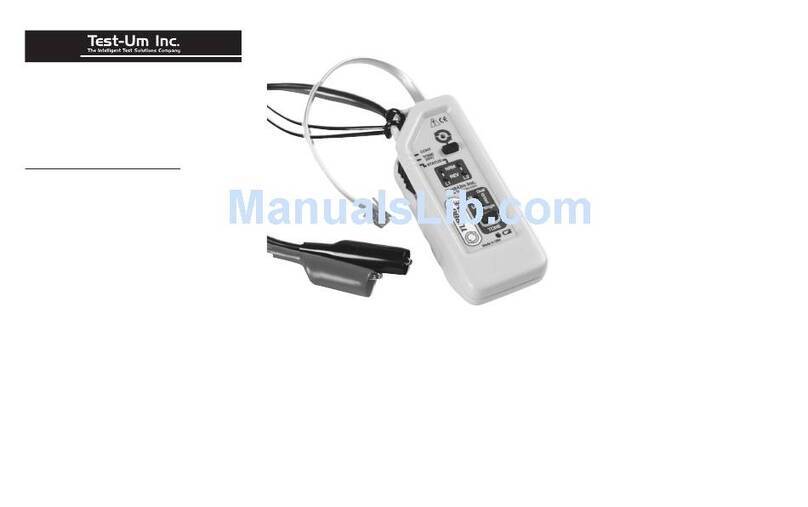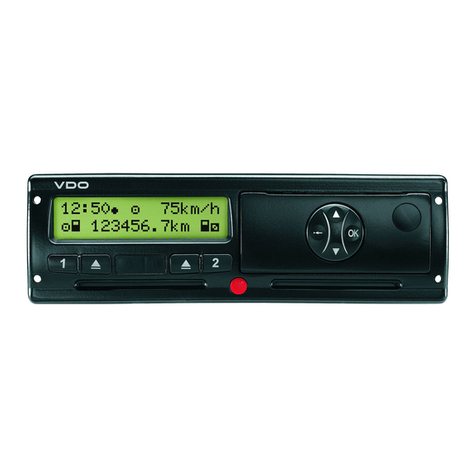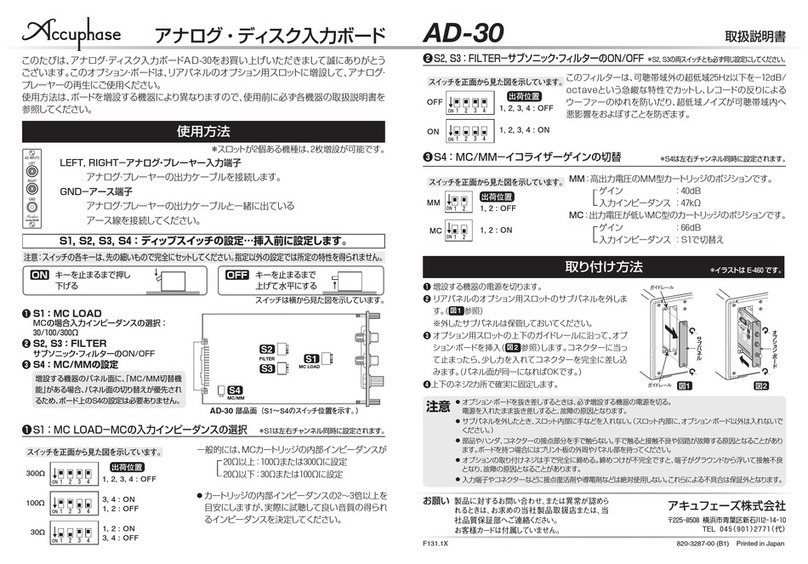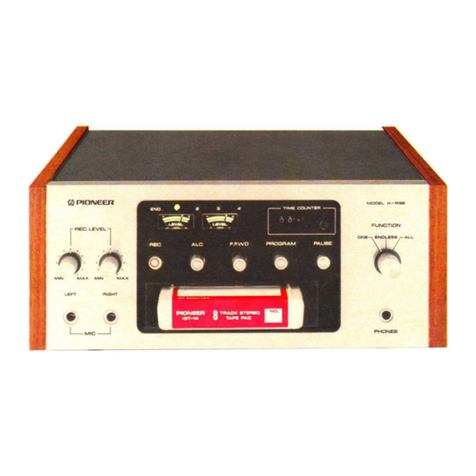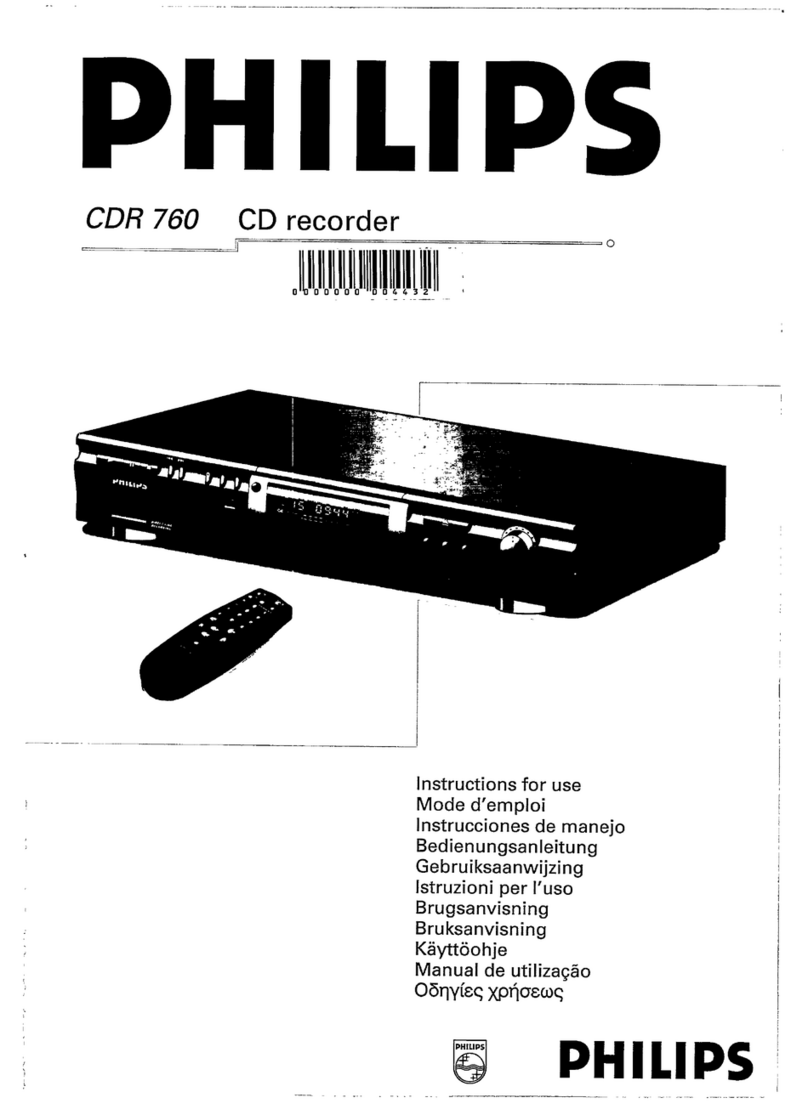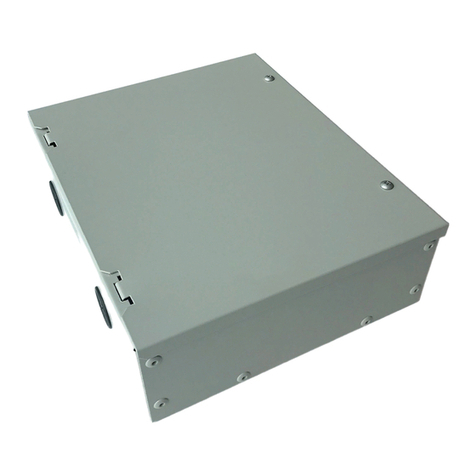Test-Um TG100 User manual

Instructions
for Use
To check the status of a
phone circuit
1) Move slide switch on left
side of TG100 to the “OFF
Status” position.
2) Connect black lead to
TIP and the red lead to
RING — or one lead to
each wire of the pair, if
designation is unknown.
If NRM LED turns on:
the polarity is correct and
the black lead is connected
to TIP.
If the REV turns on:
the leads are reversed.
If the NRM or REV LED is bright:
the line is not in use.
If the LED is dim: the circuit is in use.
If both NRM and REV are on or flashing:
an AC voltage is present.
Application Hints
The TIP signal is nominally at ground potential.
So RING can be identified by attaching the black
lead to a ground point and connecting the red
lead to each wire of the pair. When the red lead
is connected to RING, the NRM LED will light.
Part No.
TG100
Tone Generator
Operating Instructions
Features
•Three distinctly different tones selected from
front panel
•Constant tone amplitude over life of battery
•Two tone amplitude levels —normal and half
•Auto-off of tone after 3 hours —no dead
battery if left on
•Tone may be added in any mode —allows
phone sets without monitor feature to pick
up tone
•No power draw in continuity mode with leads
open —no dead battery if left in continuity
•Separate Talk Battery mode for increased
voltage and power for Butt sets
•RJ jack allows use of modular cable or
provided alligator clip leads
Warning!
Do not attach to live AC circuits. This could
cause an extreme shock hazard and damage
the TG100.
Accessory Parts
All Lil’ Buttie and Lil’Buttie PRO cord sets will
work with the TG100
LB10 Lil’Buttie Cable Set with Alligator Clips
(5.5 ft in length)
LB20 Lil’Buttie Cable Set with Angled
Piercing Clips (5.5 ft in length)
LB30 Lil’Buttie Cable Set with Angled Bed-
of-Nails Clips (5.5 ft in length)
TG10 Tone Generator Cable Set with Alligator
Clips (2 ft in length)
TG20 Tone Generator Cable Set with Angled
Bed-of-Nails Clips (2 ft in length)
Momentary Push Button:
•Turns tone on/off
•Selects amplitude and tone type
3-Position
Slide Switch
with functions:
•Talk Battery
•Continuity
•Line Status (off)
Tone LEDs
Line Status Indicators
Battery Low LED
The status LEDs also indicate a ringing line by
both NRM and REV LEDs flashing brightly. To
verify a phone line, connect the TG100 (in status
mode) to the line to be tested and call that line’s
number from another line. The TG100 status
LEDs should indicate a ringing line.
To check continuity of a circuit
Use only on non-energized circuits. Any energy
present may damage the TG100 or cause
erroneous results.
1) Move slide switch on left side of TG100 to the
“Cont”position.
www.Test-Um.com
805-383-1500

Instructions
for Use
To check the status of a
phone circuit
1) Move slide switch on left
side of TG100 to the “OFF
Status” position.
2) Connect black lead to
TIP and the red lead to
RING — or one lead to
each wire of the pair, if
designation is unknown.
If NRM LED turns on:
the polarity is correct and
the black lead is connected
to TIP.
If the REV turns on:
the leads are reversed.
If the NRM or REV LED is bright:
the line is not in use.
If the LED is dim: the circuit is in use.
If both NRM and REV are on or flashing:
an AC voltage is present.
Application Hints
The TIP signal is nominally at ground potential.
So RING can be identified by attaching the black
lead to a ground point and connecting the red
lead to each wire of the pair. When the red lead
is connected to RING, the NRM LED will light.
Part No.
TG100
Tone Generator
Operating Instructions
Features
•Three distinctly different tones selected from
front panel
•Constant tone amplitude over life of battery
•Two tone amplitude levels —normal and half
•Auto-off of tone after 3 hours —no dead
battery if left on
•Tone may be added in any mode —allows
phone sets without monitor feature to pick
up tone
•No power draw in continuity mode with leads
open —no dead battery if left in continuity
•Separate Talk Battery mode for increased
voltage and power for Butt sets
•RJ jack allows use of modular cable or
provided alligator clip leads
Warning!
Do not attach to live AC circuits. This could
cause an extreme shock hazard and damage
the TG100.
Accessory Parts
All Lil’ Buttie and Lil’Buttie PRO cord sets will
work with the TG100
LB10 Lil’Buttie Cable Set with Alligator Clips
(5.5 ft in length)
LB20 Lil’Buttie Cable Set with Angled
Piercing Clips (5.5 ft in length)
LB30 Lil’Buttie Cable Set with Angled Bed-
of-Nails Clips (5.5 ft in length)
TG10 Tone Generator Cable Set with Alligator
Clips (2 ft in length)
TG20 Tone Generator Cable Set with Angled
Bed-of-Nails Clips (2 ft in length)
Momentary Push Button:
•Turns tone on/off
•Selects amplitude and tone type
3-Position
Slide Switch
with functions:
•Talk Battery
•Continuity
•Line Status (off)
Tone LEDs
Line Status Indicators
Battery Low LED
The status LEDs also indicate a ringing line by
both NRM and REV LEDs flashing brightly. To
verify a phone line, connect the TG100 (in status
mode) to the line to be tested and call that line’s
number from another line. The TG100 status
LEDs should indicate a ringing line.
To check continuity of a circuit
Use only on non-energized circuits. Any energy
present may damage the TG100 or cause
erroneous results.
1) Move slide switch on left side of TG100 to the
“Cont”position.
www.Test-Um.com
805-383-1500

2) Connect TG100’s leads to each end of the
circuit to be tested. If the DC resistance of
the path is approximately 11,000 ohms or
less, the REV LED will light.
3) Move slide switch to “OFF Status”when
finished. The TG100 draws no power when
the leads are open, but the leads touching
during storage could drain the battery.
To supply talk battery power
1) Move slide switch on left side of TG100 to the
“Talk Battery”position.
2) Connect TG100 in series with a phone set at
one end of a dead pair. To connect the TG100
in series with a phone set, connect one lead
from the TG100 to one lead of the phone set
and connect the two remaining free leads to
the dead pair.
3) Connect a second phone set across the dead
pair at the other end of the line.
4) Take both phone sets off hook and communica-
tions is established.
5) Move slide switch to “OFF Status”when
finished. The TG100 draws no power when
the leads are open, but the leads touching
during storage could drain the battery.
To send a tone for tracing
1) Move slide switch on left side of TG100 to the
“OFF Status”position for normal operation,
especially if toning powered phone lines. See
“Application Hints”for other configurations.
2) Connect leads across the line, or attach one lead to
ground and the other lead to one wire of a cable or
pair to be traced.
3) Press the button on the unit briefly to turn on the
signal. If the desired signal level indicator (HI or LO)
is not blinking, press the button briefly until the
correct signal level is selected. The TG100 rotates
through a HI-LO-OFF sequence.
4) Select a different signal type, if desired (see “To
Select or Verify Signal Type”).
5) To turn off the signal, press the button briefly.
If it has been more than 15 seconds since the
last press, the TG100 will go directly to OFF.
If not, a second press may be necessary, if the
unit was set to HI.
Application Hints:
When tracing wires terminated to a terminal block,
such as a “66 block”, attaching both TG100 leads
to the cable or pair tends to contain the signal
within the cable. The tracer must nearly touch
the end of the cable to detect the signal, which
is helpful when the wires are close together, as
when terminated. The LO amplitude setting may
generate a stronger signal when connecting both
leads of the TG100 to a cable, by reducing the field
canceling effect of having a signal and it’s return
close together, especially in twisted pair cable. A
modular phone cable can be used to connect the
TG100 directly to a wall jack.
When tracing along cable runs and to maximize
radiated signal, connect one lead of the TG100
to the wire or cable, and the other end to ground
(case of an electrical box, electrical conduit,
metallic water pipe or ground rod). If no ground
is available, do not connect the other lead to
anything —let it dangle as near to the earth as
possible. Connect the TG100 to the ungrounded
shield of a coax cable. The shield will do it's job,
if connected to the center lead, and block the tone.
The LO amplitude setting is useful if there is too
much bleeding of the signal, or the tracer being
used has fixed volume and is overloading.
There are several useful techniques that take
advantage of the ability to generate tone in any
slide switch position. Both leads of the TG100 must
be connected to the pair in order for them to work.
With tone on, the “Cont”mode can be used on a
dead line to indicate finding the line to a helper,
or to verify having found both leads of a pair.
Once the pair is presumed to be found, short
out the pair and the REV LED should light on the
TG100, indicating the pair has been found. The
“Talk Battery”mode can be used with tone to allow
a phone set without a passive monitor function to
hear the tone when the phone leads are attached
across the pair the TG100 is powering.
To Select or Verify Signal Type
The TG100 has three distinctly different tone types
available —one single and two dual (or warble) tones.
1) Press and hold the front panel button until both the
HI and LO LEDs turn on —this indicates entry into
the tone style selection function.
2) Continue holding the button down, one of the
two LEDs will turn on steady or flash to indicate
the currently selected type. The Sngl LED will
turn on steady to indicate the single type is
selected. The Dual LED will either flash for one
of the dual tones, or be on steady for the other.
Releasing the button before two seconds have
passed will leave the signal type unchanged.
3) To select another signal type, continue holding
the button down until the desired type is
displayed. The TG100 will continue to cycle
through the three types until the button is
released, or the unit times out and turns off
(10 to 12 seconds).
Hint:
The currently selected tone type is generated
at the RJ jack once the signal selection
function is entered. Holding a tone tracer
near the jack will allow the user to hear each
tone type as it is selected.
Battery Replacement
1) Remove screw on the rear of the TG100
with a #1 Phillips screwdriver. Carefully
open the tester.
2) Remove old battery and disconnect from
battery leads.
3) Snap the battery leads onto a new battery
(9V, alkaline). Place battery in case.
4) Close tester and replace screws. Do not
over tighten.

2) Connect TG100’s leads to each end of the
circuit to be tested. If the DC resistance of
the path is approximately 11,000 ohms or
less, the REV LED will light.
3) Move slide switch to “OFF Status”when
finished. The TG100 draws no power when
the leads are open, but the leads touching
during storage could drain the battery.
To supply talk battery power
1) Move slide switch on left side of TG100 to the
“Talk Battery”position.
2) Connect TG100 in series with a phone set at
one end of a dead pair. To connect the TG100
in series with a phone set, connect one lead
from the TG100 to one lead of the phone set
and connect the two remaining free leads to
the dead pair.
3) Connect a second phone set across the dead
pair at the other end of the line.
4) Take both phone sets off hook and communica-
tions is established.
5) Move slide switch to “OFF Status”when
finished. The TG100 draws no power when
the leads are open, but the leads touching
during storage could drain the battery.
To send a tone for tracing
1) Move slide switch on left side of TG100 to the
“OFF Status”position for normal operation,
especially if toning powered phone lines. See
“Application Hints”for other configurations.
2) Connect leads across the line, or attach one lead to
ground and the other lead to one wire of a cable or
pair to be traced.
3) Press the button on the unit briefly to turn on the
signal. If the desired signal level indicator (HI or LO)
is not blinking, press the button briefly until the
correct signal level is selected. The TG100 rotates
through a HI-LO-OFF sequence.
4) Select a different signal type, if desired (see “To
Select or Verify Signal Type”).
5) To turn off the signal, press the button briefly.
If it has been more than 15 seconds since the
last press, the TG100 will go directly to OFF.
If not, a second press may be necessary, if the
unit was set to HI.
Application Hints:
When tracing wires terminated to a terminal block,
such as a “66 block”, attaching both TG100 leads
to the cable or pair tends to contain the signal
within the cable. The tracer must nearly touch
the end of the cable to detect the signal, which
is helpful when the wires are close together, as
when terminated. The LO amplitude setting may
generate a stronger signal when connecting both
leads of the TG100 to a cable, by reducing the field
canceling effect of having a signal and it’s return
close together, especially in twisted pair cable. A
modular phone cable can be used to connect the
TG100 directly to a wall jack.
When tracing along cable runs and to maximize
radiated signal, connect one lead of the TG100
to the wire or cable, and the other end to ground
(case of an electrical box, electrical conduit,
metallic water pipe or ground rod). If no ground
is available, do not connect the other lead to
anything —let it dangle as near to the earth as
possible. Connect the TG100 to the ungrounded
shield of a coax cable. The shield will do it's job,
if connected to the center lead, and block the tone.
The LO amplitude setting is useful if there is too
much bleeding of the signal, or the tracer being
used has fixed volume and is overloading.
There are several useful techniques that take
advantage of the ability to generate tone in any
slide switch position. Both leads of the TG100 must
be connected to the pair in order for them to work.
With tone on, the “Cont”mode can be used on a
dead line to indicate finding the line to a helper,
or to verify having found both leads of a pair.
Once the pair is presumed to be found, short
out the pair and the REV LED should light on the
TG100, indicating the pair has been found. The
“Talk Battery”mode can be used with tone to allow
a phone set without a passive monitor function to
hear the tone when the phone leads are attached
across the pair the TG100 is powering.
To Select or Verify Signal Type
The TG100 has three distinctly different tone types
available —one single and two dual (or warble) tones.
1) Press and hold the front panel button until both the
HI and LO LEDs turn on —this indicates entry into
the tone style selection function.
2) Continue holding the button down, one of the
two LEDs will turn on steady or flash to indicate
the currently selected type. The Sngl LED will
turn on steady to indicate the single type is
selected. The Dual LED will either flash for one
of the dual tones, or be on steady for the other.
Releasing the button before two seconds have
passed will leave the signal type unchanged.
3) To select another signal type, continue holding
the button down until the desired type is
displayed. The TG100 will continue to cycle
through the three types until the button is
released, or the unit times out and turns off
(10 to 12 seconds).
Hint:
The currently selected tone type is generated
at the RJ jack once the signal selection
function is entered. Holding a tone tracer
near the jack will allow the user to hear each
tone type as it is selected.
Battery Replacement
1) Remove screw on the rear of the TG100
with a #1 Phillips screwdriver. Carefully
open the tester.
2) Remove old battery and disconnect from
battery leads.
3) Snap the battery leads onto a new battery
(9V, alkaline). Place battery in case.
4) Close tester and replace screws. Do not
over tighten.

2) Connect TG100’s leads to each end of the
circuit to be tested. If the DC resistance of
the path is approximately 11,000 ohms or
less, the REV LED will light.
3) Move slide switch to “OFF Status”when
finished. The TG100 draws no power when
the leads are open, but the leads touching
during storage could drain the battery.
To supply talk battery power
1) Move slide switch on left side of TG100 to the
“Talk Battery”position.
2) Connect TG100 in series with a phone set at
one end of a dead pair. To connect the TG100
in series with a phone set, connect one lead
from the TG100 to one lead of the phone set
and connect the two remaining free leads to
the dead pair.
3) Connect a second phone set across the dead
pair at the other end of the line.
4) Take both phone sets off hook and communica-
tions is established.
5) Move slide switch to “OFF Status”when
finished. The TG100 draws no power when
the leads are open, but the leads touching
during storage could drain the battery.
To send a tone for tracing
1) Move slide switch on left side of TG100 to the
“OFF Status”position for normal operation,
especially if toning powered phone lines. See
“Application Hints”for other configurations.
2) Connect leads across the line, or attach one lead to
ground and the other lead to one wire of a cable or
pair to be traced.
3) Press the button on the unit briefly to turn on the
signal. If the desired signal level indicator (HI or LO)
is not blinking, press the button briefly until the
correct signal level is selected. The TG100 rotates
through a HI-LO-OFF sequence.
4) Select a different signal type, if desired (see “To
Select or Verify Signal Type”).
5) To turn off the signal, press the button briefly.
If it has been more than 15 seconds since the
last press, the TG100 will go directly to OFF.
If not, a second press may be necessary, if the
unit was set to HI.
Application Hints:
When tracing wires terminated to a terminal block,
such as a “66 block”, attaching both TG100 leads
to the cable or pair tends to contain the signal
within the cable. The tracer must nearly touch
the end of the cable to detect the signal, which
is helpful when the wires are close together, as
when terminated. The LO amplitude setting may
generate a stronger signal when connecting both
leads of the TG100 to a cable, by reducing the field
canceling effect of having a signal and it’s return
close together, especially in twisted pair cable. A
modular phone cable can be used to connect the
TG100 directly to a wall jack.
When tracing along cable runs and to maximize
radiated signal, connect one lead of the TG100
to the wire or cable, and the other end to ground
(case of an electrical box, electrical conduit,
metallic water pipe or ground rod). If no ground
is available, do not connect the other lead to
anything —let it dangle as near to the earth as
possible. Connect the TG100 to the ungrounded
shield of a coax cable. The shield will do it's job,
if connected to the center lead, and block the tone.
The LO amplitude setting is useful if there is too
much bleeding of the signal, or the tracer being
used has fixed volume and is overloading.
There are several useful techniques that take
advantage of the ability to generate tone in any
slide switch position. Both leads of the TG100 must
be connected to the pair in order for them to work.
With tone on, the “Cont”mode can be used on a
dead line to indicate finding the line to a helper,
or to verify having found both leads of a pair.
Once the pair is presumed to be found, short
out the pair and the REV LED should light on the
TG100, indicating the pair has been found. The
“Talk Battery”mode can be used with tone to allow
a phone set without a passive monitor function to
hear the tone when the phone leads are attached
across the pair the TG100 is powering.
To Select or Verify Signal Type
The TG100 has three distinctly different tone types
available —one single and two dual (or warble) tones.
1) Press and hold the front panel button until both the
HI and LO LEDs turn on —this indicates entry into
the tone style selection function.
2) Continue holding the button down, one of the
two LEDs will turn on steady or flash to indicate
the currently selected type. The Sngl LED will
turn on steady to indicate the single type is
selected. The Dual LED will either flash for one
of the dual tones, or be on steady for the other.
Releasing the button before two seconds have
passed will leave the signal type unchanged.
3) To select another signal type, continue holding
the button down until the desired type is
displayed. The TG100 will continue to cycle
through the three types until the button is
released, or the unit times out and turns off
(10 to 12 seconds).
Hint:
The currently selected tone type is generated
at the RJ jack once the signal selection
function is entered. Holding a tone tracer
near the jack will allow the user to hear each
tone type as it is selected.
Battery Replacement
1) Remove screw on the rear of the TG100
with a #1 Phillips screwdriver. Carefully
open the tester.
2) Remove old battery and disconnect from
battery leads.
3) Snap the battery leads onto a new battery
(9V, alkaline). Place battery in case.
4) Close tester and replace screws. Do not
over tighten.

2) Connect TG100’s leads to each end of the
circuit to be tested. If the DC resistance of
the path is approximately 11,000 ohms or
less, the REV LED will light.
3) Move slide switch to “OFF Status”when
finished. The TG100 draws no power when
the leads are open, but the leads touching
during storage could drain the battery.
To supply talk battery power
1) Move slide switch on left side of TG100 to the
“Talk Battery”position.
2) Connect TG100 in series with a phone set at
one end of a dead pair. To connect the TG100
in series with a phone set, connect one lead
from the TG100 to one lead of the phone set
and connect the two remaining free leads to
the dead pair.
3) Connect a second phone set across the dead
pair at the other end of the line.
4) Take both phone sets off hook and communica-
tions is established.
5) Move slide switch to “OFF Status”when
finished. The TG100 draws no power when
the leads are open, but the leads touching
during storage could drain the battery.
To send a tone for tracing
1) Move slide switch on left side of TG100 to the
“OFF Status”position for normal operation,
especially if toning powered phone lines. See
“Application Hints”for other configurations.
2) Connect leads across the line, or attach one lead to
ground and the other lead to one wire of a cable or
pair to be traced.
3) Press the button on the unit briefly to turn on the
signal. If the desired signal level indicator (HI or LO)
is not blinking, press the button briefly until the
correct signal level is selected. The TG100 rotates
through a HI-LO-OFF sequence.
4) Select a different signal type, if desired (see “To
Select or Verify Signal Type”).
5) To turn off the signal, press the button briefly.
If it has been more than 15 seconds since the
last press, the TG100 will go directly to OFF.
If not, a second press may be necessary, if the
unit was set to HI.
Application Hints:
When tracing wires terminated to a terminal block,
such as a “66 block”, attaching both TG100 leads
to the cable or pair tends to contain the signal
within the cable. The tracer must nearly touch
the end of the cable to detect the signal, which
is helpful when the wires are close together, as
when terminated. The LO amplitude setting may
generate a stronger signal when connecting both
leads of the TG100 to a cable, by reducing the field
canceling effect of having a signal and it’s return
close together, especially in twisted pair cable. A
modular phone cable can be used to connect the
TG100 directly to a wall jack.
When tracing along cable runs and to maximize
radiated signal, connect one lead of the TG100
to the wire or cable, and the other end to ground
(case of an electrical box, electrical conduit,
metallic water pipe or ground rod). If no ground
is available, do not connect the other lead to
anything —let it dangle as near to the earth as
possible. Connect the TG100 to the ungrounded
shield of a coax cable. The shield will do it's job,
if connected to the center lead, and block the tone.
The LO amplitude setting is useful if there is too
much bleeding of the signal, or the tracer being
used has fixed volume and is overloading.
There are several useful techniques that take
advantage of the ability to generate tone in any
slide switch position. Both leads of the TG100 must
be connected to the pair in order for them to work.
With tone on, the “Cont”mode can be used on a
dead line to indicate finding the line to a helper,
or to verify having found both leads of a pair.
Once the pair is presumed to be found, short
out the pair and the REV LED should light on the
TG100, indicating the pair has been found. The
“Talk Battery”mode can be used with tone to allow
a phone set without a passive monitor function to
hear the tone when the phone leads are attached
across the pair the TG100 is powering.
To Select or Verify Signal Type
The TG100 has three distinctly different tone types
available —one single and two dual (or warble) tones.
1) Press and hold the front panel button until both the
HI and LO LEDs turn on —this indicates entry into
the tone style selection function.
2) Continue holding the button down, one of the
two LEDs will turn on steady or flash to indicate
the currently selected type. The Sngl LED will
turn on steady to indicate the single type is
selected. The Dual LED will either flash for one
of the dual tones, or be on steady for the other.
Releasing the button before two seconds have
passed will leave the signal type unchanged.
3) To select another signal type, continue holding
the button down until the desired type is
displayed. The TG100 will continue to cycle
through the three types until the button is
released, or the unit times out and turns off
(10 to 12 seconds).
Hint:
The currently selected tone type is generated
at the RJ jack once the signal selection
function is entered. Holding a tone tracer
near the jack will allow the user to hear each
tone type as it is selected.
Battery Replacement
1) Remove screw on the rear of the TG100
with a #1 Phillips screwdriver. Carefully
open the tester.
2) Remove old battery and disconnect from
battery leads.
3) Snap the battery leads onto a new battery
(9V, alkaline). Place battery in case.
4) Close tester and replace screws. Do not
over tighten.

Instructions
for Use
To check the status of a
phone circuit
1) Move slide switch on left
side of TG100 to the “OFF
Status” position.
2) Connect black lead to
TIP and the red lead to
RING — or one lead to
each wire of the pair, if
designation is unknown.
If NRM LED turns on:
the polarity is correct and
the black lead is connected
to TIP.
If the REV turns on:
the leads are reversed.
If the NRM or REV LED is bright:
the line is not in use.
If the LED is dim: the circuit is in use.
If both NRM and REV are on or flashing:
an AC voltage is present.
Application Hints
The TIP signal is nominally at ground potential.
So RING can be identified by attaching the black
lead to a ground point and connecting the red
lead to each wire of the pair. When the red lead
is connected to RING, the NRM LED will light.
Part No.
TG100
Tone Generator
Operating Instructions
Features
•Three distinctly different tones selected from
front panel
•Constant tone amplitude over life of battery
•Two tone amplitude levels —normal and half
•Auto-off of tone after 3 hours —no dead
battery if left on
•Tone may be added in any mode —allows
phone sets without monitor feature to pick
up tone
•No power draw in continuity mode with leads
open —no dead battery if left in continuity
•Separate Talk Battery mode for increased
voltage and power for Butt sets
•RJ jack allows use of modular cable or
provided alligator clip leads
Warning!
Do not attach to live AC circuits. This could
cause an extreme shock hazard and damage
the TG100.
Accessory Parts
All Lil’ Buttie and Lil’Buttie PRO cord sets will
work with the TG100
LB10 Lil’Buttie Cable Set with Alligator Clips
(5.5 ft in length)
LB20 Lil’Buttie Cable Set with Angled
Piercing Clips (5.5 ft in length)
LB30 Lil’Buttie Cable Set with Angled Bed-
of-Nails Clips (5.5 ft in length)
TG10 Tone Generator Cable Set with Alligator
Clips (2 ft in length)
TG20 Tone Generator Cable Set with Angled
Bed-of-Nails Clips (2 ft in length)
Momentary Push Button:
•Turns tone on/off
•Selects amplitude and tone type
3-Position
Slide Switch
with functions:
•Talk Battery
•Continuity
•Line Status (off)
Tone LEDs
Line Status Indicators
Battery Low LED
The status LEDs also indicate a ringing line by
both NRM and REV LEDs flashing brightly. To
verify a phone line, connect the TG100 (in status
mode) to the line to be tested and call that line’s
number from another line. The TG100 status
LEDs should indicate a ringing line.
To check continuity of a circuit
Use only on non-energized circuits. Any energy
present may damage the TG100 or cause
erroneous results.
1) Move slide switch on left side of TG100 to the
“Cont”position.
www.Test-Um.com
805-383-1500
Other manuals for TG100
1
Table of contents
Other Test-Um Recording Equipment manuals
Popular Recording Equipment manuals by other brands
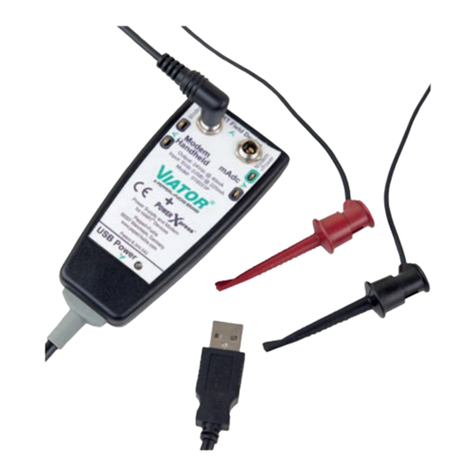
Pepperl+Fuchs
Pepperl+Fuchs Viator PowerXpress HM-PF-USB-PWRX-010031P manual

Amptone Lab
Amptone Lab XY MIDIPAD MINi user manual

Car Solutions
Car Solutions QVI-LVTX-1CH-V7 installation manual

Rice Lake
Rice Lake EtherNet/ IP Installation and programming manual

Tascam
Tascam Portacapture X8 Reference manual

Electro-Harmonix
Electro-Harmonix 1440 quick start guide
